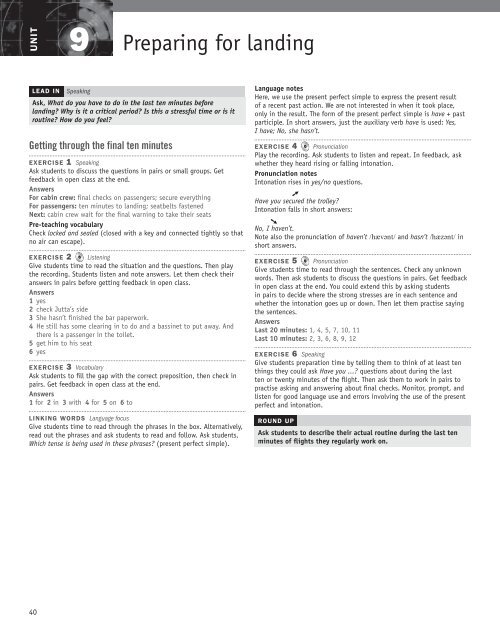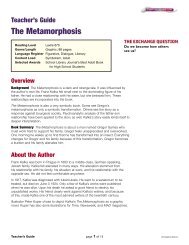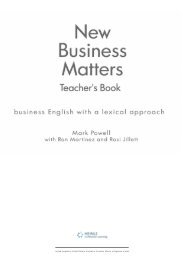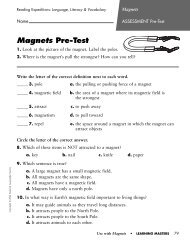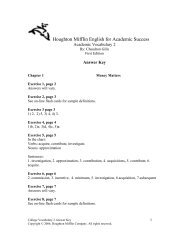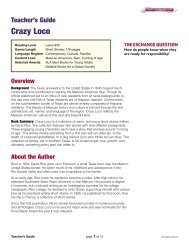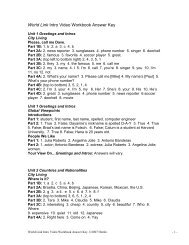English for Cabin Crew Trainer's Guide - Heinle
English for Cabin Crew Trainer's Guide - Heinle
English for Cabin Crew Trainer's Guide - Heinle
Create successful ePaper yourself
Turn your PDF publications into a flip-book with our unique Google optimized e-Paper software.
UNIT<br />
LEAD IN Speaking<br />
9 Preparing <strong>for</strong> landing<br />
Ask, What do you have to do in the last ten minutes be<strong>for</strong>e<br />
landing? Why is it a critical period? Is this a stressful time or is it<br />
routine? How do you feel?<br />
Getting through the final ten minutes<br />
EXERCISE 1 Speaking<br />
Ask students to discuss the questions in pairs or small groups. Get<br />
feedback in open class at the end.<br />
Answers<br />
For cabin crew: fi nal checks on passengers; secure everything<br />
For passengers: ten minutes to landing; seatbelts fastened<br />
Next: cabin crew wait <strong>for</strong> the fi nal warning to take their seats<br />
Pre-teaching vocabulary<br />
Check locked and sealed (closed with a key and connected tightly so that<br />
no air can escape).<br />
EXERCISE 2 Listening<br />
Give students time to read the situation and the questions. Then play<br />
the recording. Students listen and note answers. Let them check their<br />
answers in pairs be<strong>for</strong>e getting feedback in open class.<br />
Answers<br />
1 yes<br />
2 check Jutta’s side<br />
3 She hasn’t fi nished the bar paperwork.<br />
4 He still has some clearing in to do and a bassinet to put away. And<br />
there is a passenger in the toilet.<br />
5 get him to his seat<br />
6 yes<br />
EXERCISE 3 Vocabulary<br />
Ask students to fi ll the gap with the correct preposition, then check in<br />
pairs. Get feedback in open class at the end.<br />
Answers<br />
1 <strong>for</strong> 2 in 3 with 4 <strong>for</strong> 5 on 6 to<br />
LINKING WORDS Language focus<br />
Give students time to read through the phrases in the box. Alternatively,<br />
read out the phrases and ask students to read and follow. Ask students,<br />
Which tense is being used in these phrases? (present perfect simple).<br />
40<br />
Language notes<br />
Here, we use the present perfect simple to express the present result<br />
of a recent past action. We are not interested in when it took place,<br />
only in the result. The <strong>for</strong>m of the present perfect simple is have + past<br />
participle. In short answers, just the auxiliary verb have is used: Yes,<br />
I have; No, she hasn’t.<br />
EXERCISE 4 Pronunciation<br />
Play the recording. Ask students to listen and repeat. In feedback, ask<br />
whether they heard rising or falling intonation.<br />
Pronunciation notes<br />
Intonation rises in yes/no questions.<br />
➚<br />
Have you secured the trolley?<br />
Intonation falls in short answers:<br />
➘<br />
No, I haven’t.<br />
Note also the pronunciation of haven’t /h&v@nt/ and hasn’t /h&z@nt/ in<br />
short answers.<br />
EXERCISE 5 Pronunciation<br />
Give students time to read through the sentences. Check any unknown<br />
words. Then ask students to discuss the questions in pairs. Get feedback<br />
in open class at the end. You could extend this by asking students<br />
in pairs to decide where the strong stresses are in each sentence and<br />
whether the intonation goes up or down. Then let them practise saying<br />
the sentences.<br />
Answers<br />
Last 20 minutes: 1, 4, 5, 7, 10, 11<br />
Last 10 minutes: 2, 3, 6, 8, 9, 12<br />
EXERCISE 6 Speaking<br />
Give students preparation time by telling them to think of at least ten<br />
things they could ask Have you ...? questions about during the last<br />
ten or twenty minutes of the fl ight. Then ask them to work in pairs to<br />
practise asking and answering about fi nal checks. Monitor, prompt, and<br />
listen <strong>for</strong> good language use and errors involving the use of the present<br />
perfect and intonation.<br />
ROUND UP<br />
Ask students to describe their actual routine during the last ten<br />
minutes of fl ights they regularly work on.


